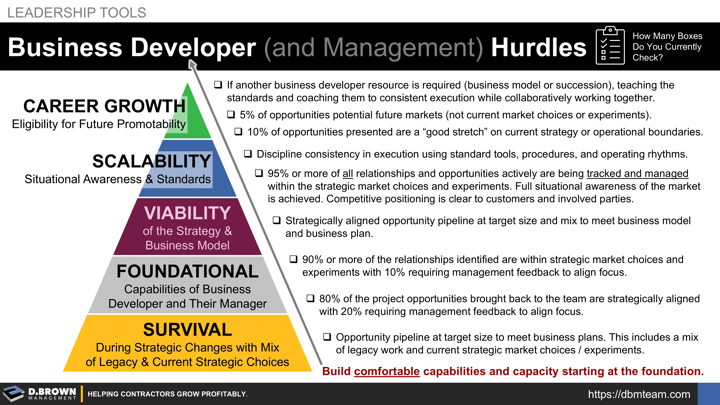Keep in mind that these phases and hurdles are just rough guidelines with plenty of nuance to them. They are there to help you and your team align objectively on where you are at and what the priorities are for improvement.
These nine hurdles are laid out across five phases:
Note that these are integrated the phases of management team development, just more granular and specific to the business development role and management of that role.
- Survival: Changes in your market, people, and stage of growth will require reevaluation of these phases and hurdles. Quite simply, you must have enough work and resulting cash flow to stay in business. This often means taking on work with customers that are less than ideal given your current strategic choices. Some of these may be legacy customers and projects that you need to find the right way to "off-board" as you move to your next stage of growth.
- Foundational: You are building the capabilities of the business developer(s), managers, and overall management system including standards, tools, and operating rhythms to manage the sales funnel all the way through to a win. This is about consistency and alignment with your strategic market choices and experiments.
- Viability: Your business model is proving out within your strategic market choices, including the operational and organizational capabilities required to support those strategic market choices. You will be performing 2 to 3X industry benchmarks for profitability, cash flow, and growth. You may need to make improvements or major changes to your strategic choices, business model, or both to achieve your desired outcomes. See warnings below.
- Sustainability: There is situational awareness of the market—including competition—and consistent adherence to standards appropriate for your stage of growth.
- Career Growth: This is about the individuals who are in the business developer job role whether they are 100% dedicated to the role or whether the responsibilities of business development are part of their role. Note that most contractors will only warrant dedicated business developer roles when they are moving past stage 4 of growth. All other general prerequisites for promotion apply.
Nine specific hurdles:
Your objective is building comfortable capabilities and capacity for business development starting at the foundation. Some may get checked off out of order but in general, you will progress through these nine hurdles.
How many boxes does your team currently check?
- Opportunity pipeline at target size to meet business plans. This includes a mix of legacy work and current strategic market choices / experiments.
- 80% of the project opportunities brought back to the team are strategically aligned with 20%, requiring management feedback to align focus.
- 90% or more of the relationships identified are within strategic market choices and experiments with 10% requiring management feedback to align focus.
- Strategically aligned opportunity pipeline at target size and mix to meet business model and business plan.
- 95% or more of all relationships and opportunities actively are being tracked and managed within the strategic market choices and experiments. Full situational awareness of the market is achieved. Competitive positioning is clear to customers and involved parties. See The Truth about Business Development.
- Discipline consistency in execution using standard tools, procedures, and operating rhythms.
- 10% of opportunities presented are a “good stretch” on current strategy or operational boundaries.
- 5% of opportunities potential future markets (not current market choices or experiments).
- If another business developer resource is required (business model or succession), teaching the standards and coaching them to consistent execution while collaboratively working together. See role promotion checklist.
Warnings about phases and hurdles:
- Don't rationalize too much when evaluating each of the hurdles. Like measuring Percent Planned Complete (PPC) on a project, it is more important to learn from the evaluation and prioritize improvements than to have a seemingly perfect score.
- All changes to strategic choices, business models, plans, processes, and people take time to settle in. Be patient, but not too patient.
- Some changes are incremental, others are major. Don't make a major change if discipline of execution and a little time is what is required. Also know when you can't incrementally improve your way to the outcomes you want.
- Avoid the comfort trap of focusing on what and who you know when making strategic changes. The momentum of prior choices made at different stages of growth and market conditions is incredibly difficult to change.
- A few strategies and relationships will emerge, but most must be very intentionally developed.
An experienced but unbiased 3rd party can be invaluable in helping you evaluate your team and navigate these changes. We will share freely anything we have learned that can help.
All relationships start with a simple conversation. Let's talk.

